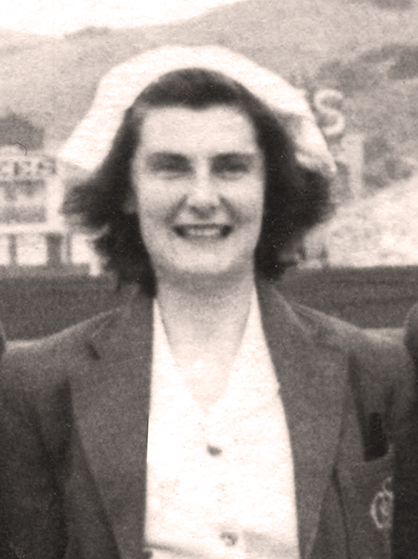A masseuse of good character
When asked what sort of innate skills those aspiring to a career in physiotherapy might need, Margaret Borland suggests that her youthful ability to perform tumbles and somersaults with ease may well have tipped the tables in her favour.
 Measuring just 5'3 but very strong and athletic, she aimed to do an Arts major in French at Otago. In 1944 however, as part of the war effort she found herself picking potatoes with other young patriots near Oamaru.
Measuring just 5'3 but very strong and athletic, she aimed to do an Arts major in French at Otago. In 1944 however, as part of the war effort she found herself picking potatoes with other young patriots near Oamaru.
An all-rounder at Waitaki Girls High School, Margaret adored tennis, netball, and gymnastics, and also served as class captain and head of house. So, when it came time to take a train to the School of Massage in Dunedin she was able to pack a number of references and reports attesting to her athletic achievements and suitability. Such papers formed an important part of the application process at that time.
Being deemed to be of suitably 'good character' Margaret was one of the first 18 young women and 18 young men handpicked by the Presbyterian Church for the first mixed intake of residents for Carrington College.
Calmness and confidence
Even though visits to the Anatomy room at 8 in the morning took extra dedication, Margaret was encouraged to develop the confidence she needed to work with those who arrived at the door of the School, which included a number of rehabilitating ex-servicemen.
One of her first patients was a heavily tattooed ex-navy man. Dressed primly for work in white uniform, cap, stockings and white shoes she hesitated to approach, but was told firmly to 'Just get on with it'. It helped that the person giving directions was the tireless and at times demanding Miss Roberts, a woman Margaret held in high esteem.
Hard work and some success
By today's standards treatments available at the time owed more to the 'healing arts' than to science.
Margaret still questions the effectiveness and safety of placing the feet of a patient suffering from an orthopaedic condition or lesions in a warm water bath which would then have an electrical charge passed through it.
She undertook further training in electrotherapy which allowed her to focus on maternity and chest therapy before working in the School of Massage gym and then Queen Mary Maternity hospital gym.
Margaret began work towards the end of New Zealand's last epidemic of tuberculosis in 1959 and recalls masking up before attending to patients of that debilitating and at times fatal disease. There was also the pervasive fear of poliomyelitis (infantile paralysis) and she spent much of this time at the small physio pool which was used to alleviate the symptoms of polio.
While Margaret found this work both hard and demanding, she tells us that the rewards would always follow. She mentions the look of delight on the face of one polio patient after hands-on treatment when the patient found that they were able to move one finger.
Cheerful, positive and business-like in her clinical practice, New Zealand School of Massage graduate Margaret Borland now travels widely and plays golf and tennis to win.
She continues a life of vitality and of almost perpetual motion, demonstrating the apparent long term personal benefits of a lively and adventurous career in massage therapy and physiotherapy.